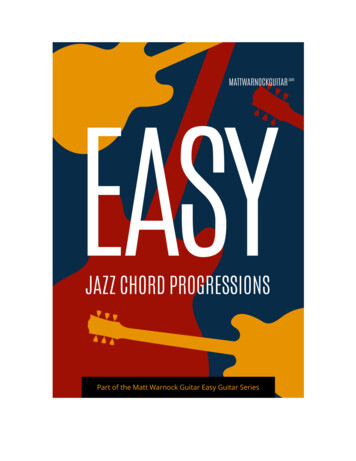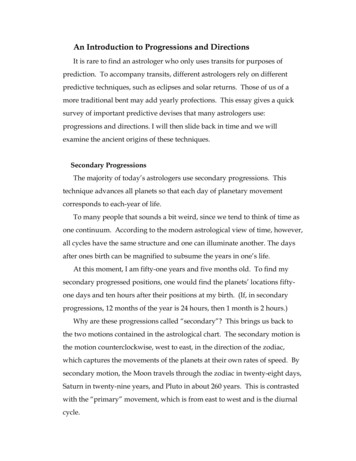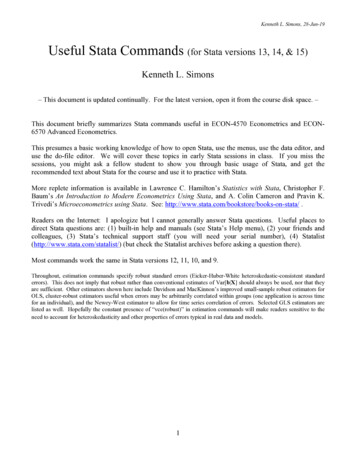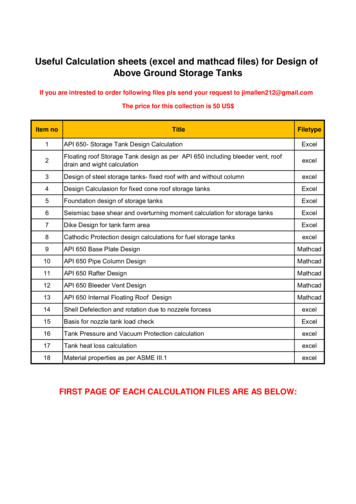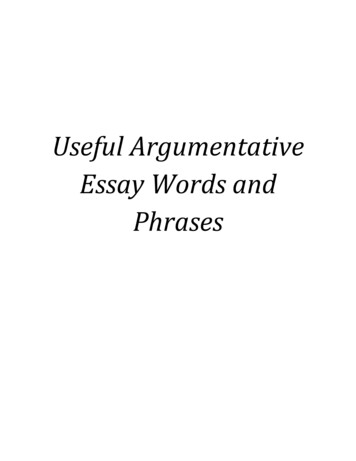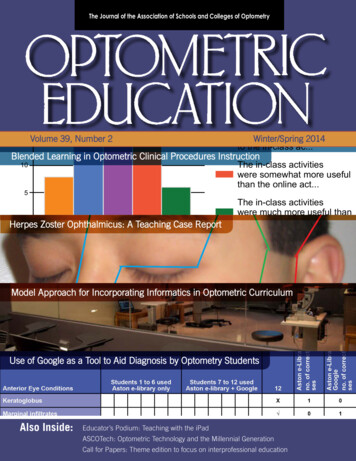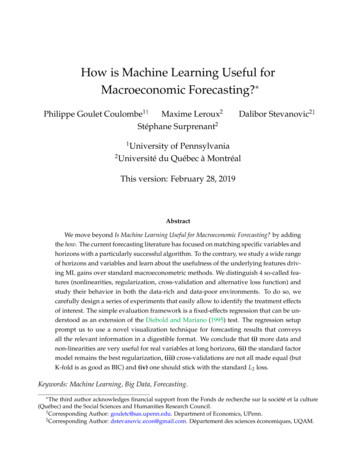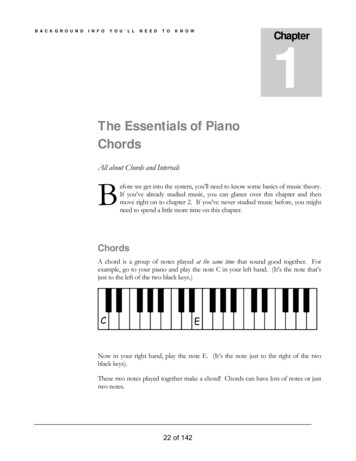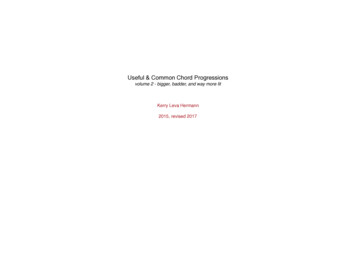
Transcription
Useful & Common Chord Progressionsvolume 2 - bigger, badder, and way more litKerry Leva Hermann2015, revised 2017
Table Of ContentsForeword / Information About This Guide3Harmonic Analysis [Roman / Arabic] Refresher3Incorporating “Technically Correct” Harmonic Analysis4Suggestions on Playing Progressions5Part I - Diatonic Chord Progressions Using “The 4 Chords Of Pop”6Part II - Diatonic Chord Progressions Outside “The 4 Chords Of Pop”9Part III - Modal Chord Progressions [Progressions that Use Borrowed Chords]11Part IV - Chord Progressions with Secondary Dominants13Useful & Common Chord Progressions, v2 - Kerry Leva Hermann, 20172
Foreword / Information About This GuideIn this guide, you’ll find a bunch of chord progressions that have been used across all genres and eras [some more frequently than others, butthese are all good to know]. Some of these progressions are mere modifications or permutations of others. Simply by omitting, adding, orreordering the same chords, we can create anything form a subtle change in attitude to a total dramatic shift in vibe.The chord progressions are arranged into four charts. Parts I and II deal entirely with diatonic chord progressions, while Parts III and IV deal withprogressions that use non-diatonic [borrowed] chords. Each progression has a clickable link to a song that uses said progression, and the specificchords in the song are provided. Each progression is also labeled as being a major progression, a minor progression, or a modal progression [withthe specific mode listed].Each chord progression is expressed in Roman numeral analysis format as well as with Arabic numbers. As a brief refresher:Roman numerals use CAPITAL letters to express major chords and lowercase letters to express minor and diminished chords:“1” chord“2” chord“3” chord“4” chord“5” chord“6” chord“7’ HEDi ii iii iv v vi vii AUGMENTEDI*II*III*IV*V*VI*VII*“6” chord“7” chordWhen using Arabic numbers, we do not need to specify a major chord [major chords are assumed by default]:“1” chordMAJOR“2” chord1“3” chord2“4” chord3“5” chord4567MINOR1m [or 1min]2m [or 2min]3m [or 3min]4m [or 4min]5m [or 5min]6m [or 6min]7m [or 7min]DIMINISHED1 [or 1dim]2 [or 2dim]3 [or 3dim]4 [or 4dim]5 [or 5dim]6 [or 6dim]7 [or 7dim]AUGMENTED1* [or 1aug]2* [or 2aug]3* [or 3aug]4* [or 4aug]5* [or 5aug]6* [or 6aug]7* [or 7aug][Note: Augmented chords do not occur diatonically, but may be rooted by a diatonic note.]Useful & Common Chord Progressions, v2 - Kerry Leva Hermann, 20173
Likewise, you’ll notice some Roman and Arabic numbers have a flat (b) symbol in front of them. This is the most technically accurate way toanalyse a chord progression, because it further specifies the relationship each chord’s root has to the root of your song’s key [which allows you toaccommodate borrowed chords]. Since pretty much everything is based off the major scale [whose intervallic relationships from root of scale toscale tones are all major or perfect], using a flat (b) symbol before a number indicates a minor or diminished intervallic relationship [so for example,the C chord in the key of A minor would technically be your b3 chord, because the relationship from A to C is a minor 3rd. If you were using a C#chord in the key of A, you’d call that your ‘3’ chord, because the relationship from A to C# is a major 3rd].So, for example, if you’re in the key of A, here’s how chords with certain roots get analysed:Root ofChordRoman NumeralAnalysisArabic Number Why?AnalysisBbbII, bii, bii , or bII*b2The relationship from A to Bb is a minor 2nd [lowered from the major 2nd]BII, ii, ii , or II*2The relationship from A to B is a major [natural] 2ndCbIII, biii, biii , or bIII*b3The relationship from A to C is a minor 3rd [lowered from the major 3rd]C#III, iii, iii , or III*3The relationship from A to C# is a major [natural] 3rdDIV, iv, iv , or IV*4The relationship from A to D is a perfect 4thD##IV, #iv, #iv , or#IV*#4The relationship from A to D# is an augmented [raised] 4th [this is uncommon]EbbV, bv, bv , or bV*b5The relationship from A to Eb is a diminished [lowered] 5th [this is more common]EV, v, v , or V*5The relationship from A to E is a perfect 5thFbVI, bvi, bvi , or bVI*b6The relationship from A to F is a minor 6th [lowered from the major 6th]F#VI, vi, vi , or VI*6The relationship from A to F# is a major [natural] 6thGbVII, bvii, bvii , orbVII*b7The relationship from A to G is a minor 7th [lowered from the major 7th]G#VII, vii, vii , or VII*7The relationship from A to G# is a major [natural] 7thUseful & Common Chord Progressions, v2 - Kerry Leva Hermann, 20174
Playing the Progressions / Incorporating them into Your SongsThis guide gives you the tools to hear and comprehend many different chord progressions so that you can transcribe and transpose them for yourown songs. Keep in mind that a major chord progression can only correctly transpose to any of the 12 major keys, a minor progression can onlycorrectly transpose to any of the 12 minor keys, and modal progressions can only transpose to any of the 12 keys within that specific mode. To tryto transpose a major progression to a minor key or vice versa will result in a change in chord qualities [and in some cases, different chord roots],which changes the progression altogether.So to play these chords, one of the simplest ways is to play the root of the chord in your left hand [which you may opt to double at the octave orcreate a “power chord” by way of adding the note a perefct 5th up from the root if you like] and to play the chords in your right hand. Some degreeof smooth voice leading is ideal to help you move effortlessly from chord to chord to chord, but keep in mind that you do not have to *perfectly*voice lead your chords all the time. So here’s one example of how you might play a 1 - 4 - 5 - 6m [or I - IV - V - vi] in the key of A. [Red notes right hand; blue notes left hand]Alright! Let’s get to some chord progressions. Thanks for reading. I hope this guide is helpful and inspires new song ideas for you!Useful & Common Chord Progressions, v2 - Kerry Leva Hermann, 20175
I. Diatonic Chord Progressions - The “4 Chords of Pop”Chord Progression[Roman numerals]Chord Progression[Arabic Numbers]Type ofProgressionSong ExampleChords in Examplei - v - iv1m - 5m - 4mMinorJustin Timberlake - “MyLove” [Em]Em - Bm - Am - Am/CI - IV - I - V1-4-1-5MajorChumbawumba “Tubthumping” [D]D-G-D-A[verses / choruses]I - V - IV - V1-5-4-1MajorBlink 182 - “All The Small Things” C - G - F - G[C][verses / choruses]ii - V - I2m - 5 - 1MajorMaroon 5 - “Sunday Morning” [C]Dm7 - G - Cmaj7[all except the bridge]I - vi - IV - V1 - 6m - 4 - 5MajorLed Zeppelin - “D’yer Ma’ker” [C]C - Am - F - G [chorus]vi - IV - I - V6m - 4 - 1 - 5MajorSkylar Grey - “Love The Way You Gm - Eb - Bb - FLie” [Bb][all except bridge]ORORORi - bVI - bIII - bVII1m - b6 - b3 - b7MinorTimbaland & OneRepublic “Apologize” [Cm]Cm - Ab - Eb - Bb/Dvi - IV - I6m - 4 - 1MajorSam Smith - “Stay With Me” [C]Am - F - C[verse; chorus uses G and E7or G# as turnaround chordsin the chorus]i - bIII - bVII - bVI1m - b3 - b7 - b6MinorORORORvi - I - V - IV6m - 1 - 5 - 4IV - I - V - vi4 - 1 - 5 - 6mEric Prydz - “Call On Me” [F#m]F#m - A - E - DMajorPitbull / Ke ha - “Timber” [B]G#m - B - F# - EMajorSia - “Elastic Heart” [A]D - A - E - F#mUseful & Common Chord Progressions, v2 - Kerry Leva Hermann, 20176
Chord Progression[Roman numerals]Chord Progression[Arabic Numbers]Type ofProgressionSong ExampleChords in ExampleIV - I - V4-1-5MajorAbove & Beyond w/Zoe Johnston Db - Ab - Eb- “Good For Me” [Ab]IV - I - vi - V4 - 1 - 6m - 5MajorMaroon 5 & Wiz Khalifa “Payphone” [B]E - B - G#m - F#I - V - vi - IV1 - 5 - 6m - 4MajorLady Gaga - “Paparazzi” [Ab]Ab - Eb - Fm - Db[chorus]bVI - bVII - i - bIIIb6 - b7 - 1m - b3MinorMajor Lazer DJ Snake MØ “Lean On” [Gm]Eb - F - Gm - BbORORORIV - V - vi - I4 - 5 - 6m - 1MajorIV - V - vi4 - 5 - 6mMajor [no ‘1’chord]The 1975 - “Falling For You” [Db]Gb - Ab - Bbm[flips from Bbsus4 to Bb][the chorus DOES end on the‘1’ chord, but this progressionotherwise is just these 3chords]IV - vi - V4 - 6m - 5Major [no '1'chord]Katy Perry - “TeenageDream” [Bb]Eb - Gm - FV - vi - IV - I5 - 6m - 4 - 1MajorSpice Girls - “Wannabe” [C]G - Am - F - C [verse]V - vi - IV5 - 6m - 4Major [no '1'chord]Apparat - “Komponent [TelefonTel Aviv Remix]” [G]D - Em - Cvi - IV - V - I6m - 4 - 5 - 1MajorSeven Lions & Kerli - “WorldsApart” [Eb]Cm - Ab - Bb - Eb[1st verse / chorus /drop]i - bVII - bVI - bVII1m - b7 - b6 - b7MinorActive Child - “Hanging On” [Fm]Fm - Eb - Db - Ebi - bVI - bVII - i1m - b6 - b7 - 1mMinorSnap - “Rhythm Is ADancer” [G#m]G#m - E - F# - G#mUseful & Common Chord Progressions, v2 - Kerry Leva Hermann, 20177
Chord Progression[Roman numerals]Chord Progression[Arabic Numbers]Type ofProgressionSong ExampleChords in ExampleI - V - vi - vi - V - IV1 - 5 - 6m - 6m - 5 - 4MajorJose Gonzalez - “Stay Alive” [F#]F# - C# - D#m - D#m C#m - B [verse]V - vi - V - I - IV - V5 - 6m - 5 - 1 - 4 - 5MajorDeadmau5 - “Brazil 2ndEdit” [Db]Ab - Bbm - Ab/C - Db - Gb- AbNote: There are quite a few other simple, well-known progressions that aren’t included in this chart, but worth mentioning:i - iv - v [1m - 4m - 5m] - Minor key (or a permutation thereof, such as i - iv - i - v for instance)I - IV - ii - V [1 - 4 - 2m - 5] - Major key (a variation on I - vi - ii - V)i - VI - iv - v or V [1m - 6 - 4m - 5m or 5] the Minor key version of the I - vi - IV - V major progressionI - vi - ii - V [1 - 6m - 2m - 5] OR its minor version, i - bVI - ii - v [or V] [1m - b6 - 2 - 5m or 5]Useful & Common Chord Progressions, v2 - Kerry Leva Hermann, 20178
II. Diatonic Chord Progressions Outside the “4 Chords Of Pop”Chord Progression Chord Progression Type ofSong Example[Roman numerals] [Arabic Numbers]ProgressionChords in Examplei - bVI - bIII - iv1m - b6 - b3 - 4mMinorSeba - “Painted Skies” [F]Fm - Db - Ab - BbmI - ii - vi1 - 2m - 6mMajorRihanna & Mikky Ekko “Stay” [C]C - Dm - Am [verse]I - ii - vi - IV1 - 2m - 6m - 4MajorKaty Perry - “Firework” [Ab][also the chorus of Rihanna/Mikky Ekko - “Stay”]Ab - Bbm - Fm - Db [allexcept the verses]IV - vi - V - ii4 - 6m - 5 - 2mMajor [no ‘1’chord]M83 - “Midnight City” [D]G - Bm - Asus4 - Em7ii - IV - I - V2m - 4 - 1 - 5MajorChet Faker - “Talk Is Cheap” [Bb]Cm - Eb - Bb - F7I - iii - vi - IV1 - 3m - 6m - 4MajorAdele - “Someone Like You” [A]A - C#m - F#m - D[verses]i - bIII - bVI - iv1m - b3 - b7 - 4mMinorMiley Cyrus - “WreckingBall” [Dm] (mod to F in chorus)Fm - Ab - Eb - Bbiv - bVI - i - bVII4m - b6 - 1m - b7MinorEllie Goulding - “Figure 8” [Gm]Cm - Eb - Gm - FbVI - i - bVII - ivb6 - 1m - b7 - 4mMinorLana Del Rey - “SummertimeSadness” [C#m]A - C#m - B - F#m [allexcept bridge]bVI - iv - i - bVIIb6 - 4m - 1m - b7MinorCalvin Harries & Ellie Goulding “Outside” [Dm]Bb - Gm - Dm - C[played as C/E in thechorus]i - iv - bVI - bVII1m - 4m - b6 - b7MinorCraig David - “WalkingAway” [Am]Am - Dm - F - Gi - bVII - iv - bVI1m - b7 - b6 - 4mMinorEiffel 65 - Blue [Gm]Gm - F - Eb - Cm[chorus]bVI - v - i - bVIIb6 - 5m - 1m - b7MinorAlice Deejay - “Better OffAlone” [G#m]E - D#m - G#m - F#Useful & Common Chord Progressions, v2 - Kerry Leva Hermann, 20179
Chord Progression Chord Progression Type ofSong Example[Roman numerals] [Arabic Numbers]ProgressionChords in Examplei - bVII - bVI - v1m - b7 - b6 - 5mMinorMarian Hill - “Down” [Cm]Cm - Bb - Ab - Gmi - bVII - v - bVI1m - b7 - 5m - b6MinorRitual - “Josephine” [Em]Em - D - Bm - C[all except the first halfof the chorus]i - v - bVI - iv1m - 5m - b6 - 4mMinorAlina Baraz & Galimatias “Fantasy” [Em]Em - Bm - C - Am[intro / verse 1]ii - I - IV - V2m - 1 - 4 - 5Majork?d feat.RKCB - “Discover” [Eb]Fm - Eb/G - Ab - Bb[in the chorus, there’s a Gmchord at the end of bar 4, anda Cm chord finishes off thisparticular progression]i - bIII - bVI - bVI - bVII - iv1m - b3 - b6 - b6 - b7 - 4mMinorUseful & Common Chord Progressions, v2 - Kerry Leva Hermann, 2017Skrillex Diplo Justin Bieber “Where Are Ü Now” [Fm]Fm - Ab - Db - Db - Eb Bbm [THE DROP!]10
III. Modal Chord Progressions [Progressions with Borrowed Chords]Chord Progression Chord Progression Type ofSong Example[Roman Numerals] [Arabic Numbers]ProgressionChords in ExampleImagine Dragons - “Radioactive”Bm - D - A - E[Bm]Daft Punk / Nile Rogers / PharrellBm - D - F#m - E- “Get Lucky” [Bm]Sting - “If I Ever Lose MyA - G - D [verses]Faith” [A]i - bIII - bVII - IV1m - b3 - b7 - 4Doriani - bIII - v - IV1m - b3 - 5 - 4DorianI - bVII - IV1 - b7 - 4Mixolydiani - bVII - IV1m - b7 - 4DorianChris Isaak - “Wicked Game” [B]I - v - IV1 - 5m - 4MixolydianColdplay - “Speed Of Sound” [Bb] Bb - Fm - Eb [verses]I - v - bVII - I1 - 5m - b7 - 1MixolydianI - bII - bIII1 - b2 - b3SpanishPhrygiani - bIII - IV1m - b3 - 4IV - iv - I - V4 - 4m - 1 - 5DorianMajor[4m chord borrowedfrom parallel minor]MajorI - iv - bVII1 - 4m - b7i - iv - V - i1m - 4m - 5 - 1mI - bVI - bVII1 - b6 - b7[4m and b7 chordsborrowed fromparallel minor]David Guetta / Kelly Rowland F# - C#m - Emaj7- F#“When Love Takes Over” [F#]Radiohead - “Everything In ItsC - Db - EbRight Place” [C; mod to F chorus]ALSO: Kendrick Lamar - “HowMuch A Dollar Cost” [F]Zedd / Troye Sivan “Papercut” [Fm]F - Gb - Ab - GbFm - Ab - Bb[with a turnaround of Db Cm - Ab - Bb every 8 bars]A Perfect Circle - “The Nurse Who F# - F#m - C# - G#Loved Me” [C#][chorus]Massive Attack - “ParadiseCircus” [C]HarmonicBusta Rhymes & Mariah Carey [Classical] Minor “I Know What You Want” [Ebm]Major[b6 & b7 comeEn Vogue - “Don’t Let Go” [F]from parallelminor]Useful & Common Chord Progressions, v2 - Kerry Leva Hermann, 2017Bm - A - DC - C/E - Fm - BbEbm - Abm - Bb - EbmF - Db - Ebsus2/Bb11
Chord Progression Chord Progression Type ofSong Example[Roman Numerals] [Arabic Numbers]ProgressionChords in ExampleI - v - ii - IVB - F#m/A - C#m/G# - Ei - bVI - bVI - bVII - I1 - 5m - 2m - 4Mixolydian1m - b6 - b6 - b7 - 1Eit
Song Example Chords in Example i - bVI - bIII - iv 1m - b6 - b3 - 4m Minor Seba - “Painted Skies” [F] Fm - Db - Ab - Bbm I - ii - vi 1 - 2m - 6m Major Rihanna & Mikky Ekko - “Stay” [C] C - Dm - Am [verse] I - ii - vi - IV 1 - 2m - 6m - 4 Major Katy Perry - “Firework” [Ab] [also the chorus of Rihanna/ Mikky Ekko - “Stay”]
